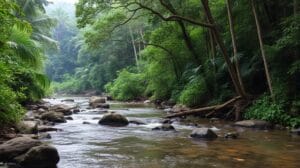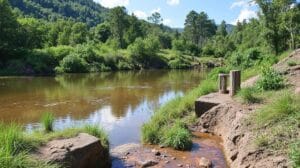Understanding the Rainforest: A Challenging Landscape of Survival
Rainforests represent some of the most intricate and demanding ecosystems on our planet, presenting extraordinary challenges for both human survival and the countless species that call these dense, humid environments home. Spanning across continents like South America, Africa, and Southeast Asia, these remarkable landscapes are characterized by their incredible biodiversity, complex ecological interactions, and extreme environmental conditions.
The Unique Challenges of Rainforest Survival
Surviving in a rainforest requires a multifaceted approach that combines physical preparedness, environmental knowledge, and adaptive strategies. Unlike other ecosystems, rainforests present a unique set of survival challenges that test human endurance and resilience at every turn.
Essential Survival Techniques for Rainforest Navigation
1. Understanding the Rainforest Environment

- Climate and Weather
Rainforests feature a warm, humid climate that fosters continuous vegetation growth. The temperature often remains between 20°C to 25°C (68°F to 77°F). Rainfall is abundant, averaging 1750 to 2000 mm (69 to 79 inches) annually. This moisture creates slippery terrain, unpredictable weather patterns, and abundant insects. Understanding these factors is essential for planning your survival strategies.
- Flora and Fauna
The layers of the rainforest—from the forest floor to the canopy—host diverse plant and animal species. This diversity offers both resources and dangers. For instance, many plants are edible, while others can be toxic. Likewise, while many animals are harmless, some can pose threats like snakes and insects. Familiarizing yourself with local flora and fauna is necessary for survival.
2. Water Procurement and Purification

Water is paradoxically both abundant and challenging in rainforest environments. While streams, rivers, and rainfall are everywhere, untreated water can contain numerous parasites and harmful microorganisms.
Survival Water Techniques:
- Rainwater: Collect rain using leaves or tarps. It’s the safest and purest source of freshwater.
- Streams and Rivers: Always filter or boil water before consumption to eliminate parasites and bacteria. Use a bandana or cloth for filtration followed by boiling.
- Vines and Plants: Learning to identify certain vines that contain drinkable water is advantageous. Cut a section and allow the water to drain into a container
3. Shelter Construction

Choosing the right location for your shelter is vital. Look for areas that are elevated to avoid flooding, are away from falling branches, and are sheltered from strong winds.
Protecting yourself from constant moisture, insects, and potential predators requires strategic shelter design. Traditional rainforest inhabitants have developed ingenious shelter techniques that modern survivors can adapt.
Shelter Construction
Use large leaves, branches, and vines to create a makeshift shelter. Here’s a basic approach:
- Frame: Construct a frame using long branches. Lean them against a larger tree or a sturdy structure for support.
- Roof: Use large, broad leaves (like palm fronds) or bark to cover the frame. Ensure your roof has a slope to direct rain away from your sleeping area.
- Walls: If possible, add side coverage using leaves for additional protection against wind and rain.
4. Food Procurement

Rainforests are rich in potential food sources, but identifying safe, nutritious options requires extensive knowledge and careful selection.
Edible Resources:
In a rainforest, food can be abundant, but caution is critical. Familiarize yourself with the following edible plants:
- Fruits: Look for bananas, coconuts, and mangos. When foraging, ensure what you pick is free from pests or signs of spoilage.
- Roots and Tubers: Cassava and taro are common in several rainforests. Always cook roots thoroughly, as some can be toxic when raw.
- Nuts: Brazil nuts and other nuts can provide much-needed calories. Make sure to peel them properly to avoid toxins.
Hunting and Fishing
If you have the skills or tools, hunting small game like birds or rodents can provide vital protein. Use simple traps made from branches, vines, and natural elements. Fishing is also a feasible option in rainforest rivers—setup simple nets or traps, or fashion a spear from a sharpened stick
5. Navigation and Orientation

The dense canopy and complex terrain make traditional navigation methods challenging. Developing alternative orientation techniques is crucial for survival.
Navigation Techniques:
Rainforests can be disorienting due to their dense foliage. Here are techniques for navigating:
- Sun and Stars: The sun rises in the east and sets in the west; use this to gauge direction. At night, the North Star can guide your way if you’re in the Northern Hemisphere.
- Landmarks: Use unique trees or water bodies as reference points to mark your path.
- GPS: Develop compass and GPS skills for example GPS watches
6. Protection Against Wildlife

Rainforests host numerous potentially dangerous species, requiring proactive defense and awareness strategies.
Wildlife Safety Approaches:
Rainforests host numerous species, some of which can be dangerous:
- Avoid Confrontation: Many animals will avoid humans. If you spot wildlife, keep your distance and do not approach.
- Insect Protection: Use natural repellents, such as essential oils, or create barriers by wearing long sleeves and pants. Always be cautious regarding mosquito bites, which can transmit diseases.
7. Fire-Making Techniques

Fire can be vital for warmth, cooking, and safety.
Gathering Materials
Look for dry wood under leaves; resinous wood makes for good kindling. Use small twigs and dried leaves to initiate the fire.
Fire Starting Method
- Friction Method: Drill a small hole in a softer wood using a harder stick. Create shavings from the softer wood and use them to catch fire.
- Use Natural Fire Starters: Certain fungi (like Tinder Fungus) can help start a fire easily.
Psychological Survival Strategies
Beyond physical techniques, mental resilience plays a critical role in rainforest survival. The isolating and challenging environment demands psychological strength and adaptive thinking.
Mental Preparation Techniques
- Practice stress management
- Develop positive visualization skills
- Maintain a structured daily routine
- Keep psychological goals and motivations clear
- Practice mindfulness and emotional regulation
Technology and Modern Survival Tools
While traditional knowledge remains paramount, modern technology offers additional survival advantages in rainforest environments.
Recommended Survival Technologies:
- Lightweight, waterproof GPS devices
- Solar-powered charging systems
- Compact water filtration technologies
- Lightweight, multi-functional tools
- Emergency communication devices
Conclusion: Respect and Adaptation
Surviving in rainforest ecosystems is not about conquering nature, but about understanding, respecting, and adapting to its complex systems. Indigenous communities have thrived in these environments for thousands of years, demonstrating that survival is fundamentally about knowledge, respect, and harmonious interaction with the ecosystem.
Key Takeaways
- Preparation is crucial
- Knowledge trumps equipment
- Adaptability ensures survival
- Respect the ecosystem’s complexity
- Continuous learning is essential
By combining traditional wisdom, modern technologies, and a deep understanding of ecological interactions, humans can navigate and survive in even the most challenging rainforest environments.
Disclaimer: Always seek professional training and guidance before attempting survival techniques in any complex ecosystem.


